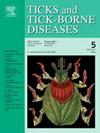反刍埃利希菌(埃利希菌科)在非洲南部弱视瘤物种中的感染率和基因分型
IF 3.4
2区 医学
Q2 INFECTIOUS DISEASES
引用次数: 0
摘要
蜱是家畜和野生动物的食血体外寄生虫。由于其广泛的地理分布和作为多种病原体载体的能力,它们被列为兽医和医学关注的前两个节肢动物科之一。钝眼虫是伊蚊科的第三大属,由于其具有传播反刍埃利希体和其他病原体的能力,在南部非洲很重要。反刍埃利希菌(Ehrlichia ruminantium)是引起反刍动物心水的病原体,是一种潜在的致命疾病,被世界动物卫生组织(World Organisation for Animal Health)列为法定疾病。在非洲南部5个国家的家畜和野生动物身上收集到双蜱。用分类键对其进行了种水平的形态鉴定,并用分子分析对其进行了种间鉴定。针对pCS20基因片段进行了初步筛选。利用Ampliseq技术对39例阳性反刍大肠杆菌进行基因分型。共收集蜱类蜱类7734只,分属4种:灰钝钝钝蜱、黑钝钝钝蜱、长钝钝钝蜱和杂色钝钝钝蜱。每个国家的反刍埃利希菌感染率从7.1%到34.1%不等。基因分型分析表明,我们的序列与菌株Gardel、Welgevonden、Um Banein、Springbokfontein 4和2、Kwanyanga和Blaauwkrans聚类。Ampliseq分析不能有效区分在南部非洲发现的菌株。这项大型研究记录了非洲南部蜱虫中反刍E.的遗传多样性和流行程度,强调了疾病控制和疫苗开发的意义。本文章由计算机程序翻译,如有差异,请以英文原文为准。
Ehrlichia ruminantium (Ehrlichiaceae) infection rates and genotyping in Amblyomma species from southern Africa
Ticks are haematophagous ectoparasites of domestic and wild animals. With their vast geographical distribution and aptitude as vectors of a large variety of pathogens, they are ranked amongst the top two arthropod families of veterinary and medical concern. Amblyomma, the third largest genus in the Ixodidae, is important in southern Africa due to its vector competence for Ehrlichia ruminantium and other pathogens. Ehrlichia ruminantium, the causative agent of heartwater, a potentially lethal disease in ruminants, is classified as a notifiable disease by the World Organisation for Animal Health. Amblyomma species ticks were collected in five southern African countries from livestock and wildlife. They were morphologically identified to species level with taxonomic keys, and species identity was confirmed with molecular assays. Preliminary screening for E. ruminantium was conducted by targeting the pCS20 gene fragment. Genotyping of 39 E. ruminantium positives was obtained using Ampliseq technology. In total, 7,734 Amblyomma ticks were collected and identified as belonging to four species: Amblyomma eburneum, Amblyomma hebraeum, Amblyomma pomposum and Amblyomma variegatum. Ehrlichia ruminantium infection rates per country ranged from 7.1 % to 34.1 %. The genotyping analysis indicated the clustering of our sequences with strains Gardel, Welgevonden, Um Banein, Springbokfontein 4 and 2, Kwanyanga, and Blaauwkrans. The Ampliseq analysis was not effective in differentiating between strains found in southern Africa. This large study documents the genetic diversity and prevalence of E. ruminantium in ticks across southern Africa, highlighting implications for disease control and vaccine development.
求助全文
通过发布文献求助,成功后即可免费获取论文全文。
去求助
来源期刊

Ticks and Tick-borne Diseases
INFECTIOUS DISEASES-MICROBIOLOGY
CiteScore
6.90
自引率
12.50%
发文量
185
审稿时长
6-12 weeks
期刊介绍:
Ticks and Tick-borne Diseases is an international, peer-reviewed scientific journal. It publishes original research papers, short communications, state-of-the-art mini-reviews, letters to the editor, clinical-case studies, announcements of pertinent international meetings, and editorials.
The journal covers a broad spectrum and brings together various disciplines, for example, zoology, microbiology, molecular biology, genetics, mathematical modelling, veterinary and human medicine. Multidisciplinary approaches and the use of conventional and novel methods/methodologies (in the field and in the laboratory) are crucial for deeper understanding of the natural processes and human behaviour/activities that result in human or animal diseases and in economic effects of ticks and tick-borne pathogens. Such understanding is essential for management of tick populations and tick-borne diseases in an effective and environmentally acceptable manner.
 求助内容:
求助内容: 应助结果提醒方式:
应助结果提醒方式:


